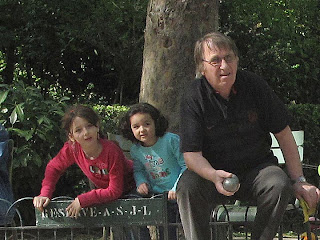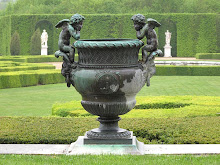This gentleman was middle aged, short and plump. He was wearing an unremarkable jacket, pants and cap, but he had a very large diamond stud in each ear. And there was something about his bearing, how he moved. I knew he would look sensational dressed as a woman, I could picture him in full drag. And then the clincher....I saw perfectly manicured long fingernails. I knew it! His tale of Paris might be even more interesting!
The opportunities for people watching while riding the bus in Paris are fantastic. And that's because everyone rides the bus. You are just as likely to see a Gucci shopping bag as a Franprix bag (aforementioned cheap grocery store). Young professional couples in tailored suits sit cheek by jowl with immigrant workers in heavy frayed coats. Young families with strollers laden with parcels jostle with self conscious teens who preen at their reflection in the window.
Paris has a lot of buses. There are 58 bus lines going all over the city and to the suburbs. Fifty eight bus lines! At each bus stop there is a map and an LCD screen telling you when the next bus will arrive. The longest we've waited was 17 minutes and that was a long time. Usually we wait 6 minutes, even on a Sunday. In 2000 the main Paris roads were narrowed with curbs to create an express lane for buses, taxis and bikes. This makes for good through ways for buses and even more congestion for cars; which was exactly the point. When you get travel information on the bus /metro website, it also tells you what your carbon footprint is, how many grams of carbon you would have produced by driving and how many by taking the bus. Pretty green idea.
Parisians are polite when a bus is stuck. This happens with great regularity when buses can't make it around a corner because someone has parked in front of the "Do not Park" sign. Buses are 12 meters long and streets here are only 6 meters wide (ish) so picture a bus going around a corner.....not much room to spare. So when a car is parked too close to the corner, the bus driver needs the eye of a surgeon to see if there's room. Drivers are simply amazing; they can get their bus through with literally centimeters to spare. Sometimes there are simply no centimeters to spare and all the driver can do is honk the horn, hoping the owner will emerge and move the vehicle. Sometimes an apologetic person runs out shouting "Pardon" and so on, and moves the car, and sometimes no one emerges. Then we sit.
Once when this happened the offending vehicle was a motorcycle, the bus was almost touching it, but couldn't make it through. We sat for 10 minutes and nothing. In the end a fellow got out of his car (also stuck) and with the help of a cafe customer muscled the motorcycle onto the sidewalk. Dave would have been out there in a flash, but the translation for " Hey, you get the back end and I'll lift the front end...ok..go!" just didn't materialize fast enough. Stymied by language.
The bus drivers of line 38 have their own website. http://bus38.online.fr/indexeng.html
Nothing official, created by the drivers because "We feel like talking about our line". There is a profile of each driver, where you can learn that Luis is a famous Portuguese vocalist, and since Jacques and Nicole (both were drivers) retired they spend their days fishing.
They feature bus 38's from around the world. And hints on how to be polite:
FRENCH LESSON #1 (!)
Bonjour... Hello
Je voudrais aller à... I'd like to go to......
Un ticket s'il vous plaît... One ticket please
Merci... Thank You
Au revoir... Good Bye
A bientôt... See you soon
Vous êtes mignon... You're cute.....(well, you're not obliged to say that!)
(I did not make this up)
Of course all this people gazing etc. assumes you can get your eyes off the view from the window. Who needs to pay 25 euros ($45!!) for a bus tour? For 28 euros you can ride the bus, the metro and the train for FIVE days. And the sights are just plain boggling.

Of course then I have to go pee. Thankfully there are modern versions of 'pissoirs' available. Just press a button and the door will magically swing open. Inside is a small bathtub for a child's doll. Wait, that's a toilet! Ok, do my business, and exit. The door magically swings shut and I hear flushing. The whole thing is being flushed, walls, floor and toilet. This is what I dreamed of when my kids were small, an entire flushing room.

Another tough day in Paris. Good thing Dave has made Cassoulet for 12!
KA
Photos by DM



















































